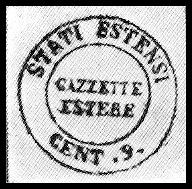
Fig. 1: the ink-pad mark
(taken from "Catalogo Sassone Specializzato" ed. 2001)
Newspaper
revenue stamps - general introduction
(Duchy-type drawing)
As already seen
for the Lombardy-Venetia, Modena Duchy too established this type of tax of out
of State newspapers, mainly on those of political nature, to hinder the diffusion
of liberal not welcome ideas.
And, as for the Lombardy-Venetia (and we'll see later for other States too) this
particular revenue stamp was regularly collected in philately even if it is
not a real postage stamp.
In February and March 1853 this fee was collected by applying a special print
directly on the newspaper, as here showed (Fig. 1); this tax was established
starting from August 1852 but it was applied only from February 1st of the following
year.

Fig. 1:
the ink-pad mark
(taken from "Catalogo Sassone Specializzato" ed. 2001)
From April 1853 (but we know that some part has been used already from March
end) this system has been substituted with a revenue stamp, fully similar to
the Duchy postage stamp, except for the value indication, to be attached to
the newspaper and to be cancelled with standard cancellation tools. It was printed
in typographic method, on colored paper in sheets of 120 pieces (therefore not
240 as for the Duchy stamps) divided in two groups of 60 side by side (other
think in two groups one on top of the other) without border typographic lines.
(Diena talks about the same group repeated twice and not of two different groups).
At the bottom there was the label "B.G. cen.9" where "B.G."
means "Bollo Gazzette".
From May 1853 this revenue was printed again, fully identical, with the exception
of the label that is written in smaller characters to avoid technical problems
during the insertion of the typographic characters of the lower label and with
the number "9" followed by a dot (while the previous one was without
the dot). This value was printed in sheets of 240 pieces as for the Duchy postage
stamps.
The quantity printed of the first type was 12,000 pieces, the quantity of the
second one was 384,000.
In the same time during 1855 a stock of revenues with the label "CENT.
9" has been prepared, printed in sheets of 240 pieces divided in 4 groups
of 60 as for the postage stamps, always on machine made paper with small threads
of red and blue color in the dough. They were never distributed due to the increase
of the rate that was brought to 10 centesimi. The existence of this revenue
stamp came to light only in 1875; later on it was introduced for the collectors
market.
On November 1st 1857 a new revenue of 10 centesimi was issued, printed with
the same plates of the equivalent postage stamp but in gray color. Even this
revenue stamp was later on substituted from February 1859 with a new type called
"Aquilotto". Please go to the specific introduction of this
value for further info.
Between the varieties there are only some double printing, some character misalignment,
some dimension variation and dot position.
Summarizing, the revenue stamps Duchy type for newspapers use are the following:
|
Double circle
cancellation
|
Black ink-pad
|
|
"B.G.
cen. 9" - big characters
|
Violet
|
|
"B.G.
cen 9." - small characters
|
Violet
|
|
9 centesimi
- not issued-
|
Gray-violet
|
|
10 centesimi
|
Gray
|